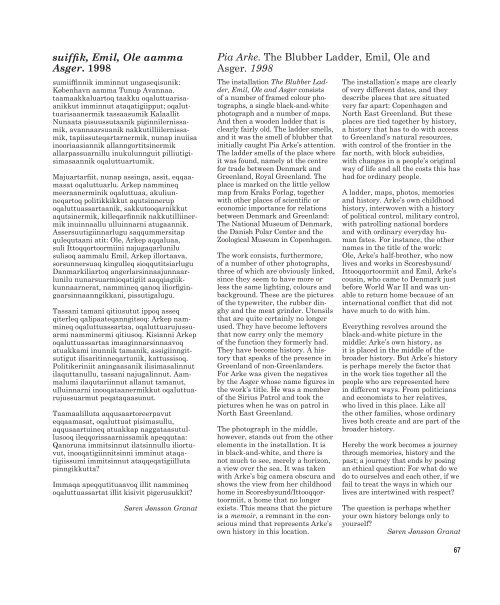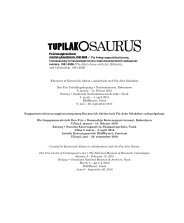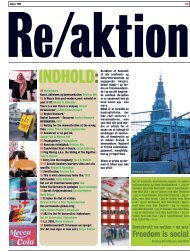tupilakosaurus - Print matters!
tupilakosaurus - Print matters!
tupilakosaurus - Print matters!
Create successful ePaper yourself
Turn your PDF publications into a flip-book with our unique Google optimized e-Paper software.
suiffik, Emil, Ole aamma<br />
Asger. 1998<br />
sumiiffinnik imminnut ungaseqisunik:<br />
København aamma Tunup Avannaa.<br />
taamaakkaluartoq taakku oqaluttuarisaanikkut<br />
imminnut ataqatigiipput; oqaluttuarisaanermik<br />
tassaasumik Kalaallit<br />
Nunaata pisuussutaanik piginnilernissamik,<br />
avannaarsuanik nakkutilliilernissamik,<br />
tapiissuteqartarnermik, nunap inuiisa<br />
inooriaasiannik allanngortitsinermik<br />
allarpassuarnillu inukulunnguit pilliutigisimasaannik<br />
oqaluttuartumik.<br />
Majuartarfiit, nunap assinga, assit, eqqaamasat<br />
oqaluttuarlu. Arkep nammineq<br />
meeraanerminik oqaluttuaa, akuliunneqartoq<br />
politikkikkut aqutsinnerup<br />
oqaluttuassartaanik, sakkutooqarnikkut<br />
aqutsinermik, killeqarfinnik nakkutilliinermik<br />
inuinnaallu ulluinnarni atugaannik.<br />
Assersuutigiinnarlugu saqqummersitap<br />
qulequtaani atit: Ole, Arkep aqqaluaa,<br />
suli Ittoqqortoormiini najugaqarlunilu<br />
sulisoq aammalu Emil, Arkep illortaava,<br />
sorsunnersuaq kingulleq sioqqutitsiarlugu<br />
Danmarkiliartoq angerlarsinnaajunnaarlunilu<br />
nunarsuarmioqatigiit aaqqiagiikkunnaarnerat,<br />
nammineq qanoq iliorfigingaarsinnaanngikkani,<br />
pissutigalugu.<br />
Tassani tamani qitiusutut ippoq asseq<br />
qiterleq qalipaateqanngitsoq: Arkep nammineq<br />
oqaluttuassartaa, oqaluttuarujussuarmi<br />
namminermi qitiusoq. Kisianni Arkep<br />
oqaluttuassartaa imaaginnarsinnaavoq<br />
atuakkami inunnik tamanik, assigiinngitsutigut<br />
ilisaritinneqartunik, kattussisoq.<br />
Politikeriniit aningaasanik ilisimasalinnut<br />
ilaquttanullu, tassani najugalinnut. Aammalumi<br />
ilaqutariinnut allanut tamanut,<br />
ulluinnarni inooqataanermikkut oqaluttuarujussuarmut<br />
peqataqaasunut.<br />
Taamaalilluta aqqusaartoreerpavut<br />
eqqaamasat, oqaluttuat pisimasullu,<br />
aqqusaartuineq atuakkap naggataasutullusooq<br />
ileqqorissaarnissamik apeqqutaa:<br />
Qanoruna immitsinnut ilatsinnullu iliortuvut,<br />
inooqatigiinnitsinni imminut ataqatigiissumi<br />
immitsinnut ataqqeqatigiilluta<br />
pinngikkutta?<br />
Immaqa apeqqutituaavoq illit nammineq<br />
oqaluttuassartat illit kisivit pigerusukkit?<br />
Søren Jønsson Granat<br />
Pia Arke. The Blubber Ladder, Emil, Ole and<br />
Asger. 1998<br />
The installation The Blubber Ladder,<br />
Emil, Ole and Asger consists<br />
of a number of framed colour photographs,<br />
a single black-and-white<br />
photograph and a number of maps.<br />
And then a wooden ladder that is<br />
clearly fairly old. The ladder smells,<br />
and it was the smell of blubber that<br />
initially caught Pia Arke’s attention.<br />
The ladder smells of the place where<br />
it was found, namely at the centre<br />
for trade between Denmark and<br />
Greenland, Royal Greenland. The<br />
place is marked on the little yellow<br />
map from Kraks Forlag, together<br />
with other places of scientific or<br />
economic importance for relations<br />
between Denmark and Greenland:<br />
The National Museum of Denmark,<br />
the Danish Polar Center and the<br />
Zoological Museum in Copenhagen.<br />
The work consists, furthermore,<br />
of a number of other photographs,<br />
three of which are obviously linked,<br />
since they seem to have more or<br />
less the same lighting, colours and<br />
background. These are the pictures<br />
of the typewriter, the rubber dinghy<br />
and the meat grinder. Utensils<br />
that are quite certainly no longer<br />
used. They have become leftovers<br />
that now carry only the memory<br />
of the function they formerly had.<br />
They have become history. A history<br />
that speaks of the presence in<br />
Greenland of non-Greenlanders.<br />
For Arke was given the negatives<br />
by the Asger whose name figures in<br />
the work’s title. He was a member<br />
of the Sirius Patrol and took the<br />
pictures when he was on patrol in<br />
North East Greenland.<br />
The photograph in the middle,<br />
however, stands out from the other<br />
elements in the installation. It is<br />
in black-and-white, and there is<br />
not much to see, merely a horizon,<br />
a view over the sea. It was taken<br />
with Arke’s big camera obscura and<br />
shows the view from her childhood<br />
home in Scoresbysund/Ittooqqortoormiit,<br />
a home that no longer<br />
exists. This means that the picture<br />
is a memoir, a remnant in the conscious<br />
mind that represents Arke’s<br />
own history in this location.<br />
The installation’s maps are clearly<br />
of very different dates, and they<br />
describe places that are situated<br />
very far apart: Copenhagen and<br />
North East Greenland. But these<br />
places are tied together by history,<br />
a history that has to do with access<br />
to Greenland’s natural resources,<br />
with control of the frontier in the<br />
far north, with block subsidies,<br />
with changes in a people’s original<br />
way of life and all the costs this has<br />
had for ordinary people.<br />
A ladder, maps, photos, memories<br />
and history. Arke’s own childhood<br />
history, interwoven with a history<br />
of political control, military control,<br />
with patrolling national borders<br />
and with ordinary everyday human<br />
fates. For instance, the other<br />
names in the title of the work:<br />
Ole, Arke’s half-brother, who now<br />
lives and works in Scoresbysund/<br />
Ittooqqortoormiit and Emil, Arke’s<br />
cousin, who came to Denmark just<br />
before World War II and was unable<br />
to return home because of an<br />
international conflict that did not<br />
have much to do with him.<br />
Everything revolves around the<br />
black-and-white picture in the<br />
middle: Arke’s own history, as<br />
it is placed in the middle of the<br />
broader history. But Arke’s history<br />
is perhaps merely the factor that<br />
in the work ties together all the<br />
people who are represented here<br />
in different ways. From politicians<br />
and economists to her relatives,<br />
who lived in this place. Like all<br />
the other families, whose ordinary<br />
lives both create and are part of the<br />
broader history.<br />
Hereby the work becomes a journey<br />
through memories, history and the<br />
past; a journey that ends by posing<br />
an ethical question: For what do we<br />
do to ourselves and each other, if we<br />
fail to treat the ways in which our<br />
lives are intertwined with respect?<br />
The question is perhaps whether<br />
your own history belongs only to<br />
yourself?<br />
Søren Jønsson Granat<br />
67




